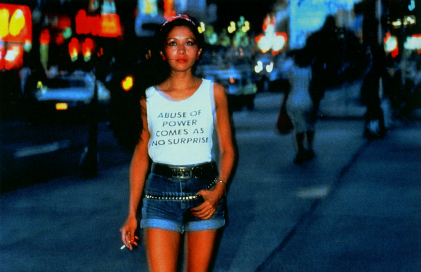Beyond Objects
For our final week, we dive into the world of Public Art, Performance Art, and Flashmobs.
For 11 weeks now we’ve been making things. Objects. Some have been physical objects like a drawing or a zine. Others have been photos or videos that exist in a slightly virtual or digital space.
But all of it has been works by an individual. You made something. If someone wants to, they can look at what you did and think about it.
Public Space
This week we’re going to move from Objects to Experiences. And we’re also going to move from “me” as all-seeing artist, to interactive experiences where your audience/participants contribute to and shape the experience. We’re not just going to offer stuff for the public to look at, we’re going to interact with them.
Public Art
Years ago “Public Art” meant that when somebody built an office tower they bought a huge, heroic steel sculpture from Alexander Calder or Mark di Suvero and plopped it on the ground in front of the big tower. Some people call this “plop art.” Don’t get me wrong, Calder and di Suvero are very compelling artists, but over time, Public Art has become more “public”.
Today when we say “Public Art” we often mean art that includes the public.
Love Beach
One Saturday I went out to Venice Beach and created a project called “Love Beach”. I took signs, paints, pastels, and wooden stakes and invited people to make signs about love and stick them in the sand near the Venice Beach Art Walls. (Next to a big Mark di Suvero sculpture!)
The “amateur” signs that people made were not individually “great art”. They were simple expressions by mostly non-artists on the beach. But the Public Art project wasn’t about genius, it was about creating a scenario for people to interact and think about art.
Juicing Performance
My friend Brian does juicing at art galleries. If you just walked in you might wonder if he was a Robek’s employee. He’s not. It may look “pedestrian”, but Brian’s juicing is an art action. You pick what things you’d like him to juice for you and while he’s doing it you have a nice conversation about almost anything. It looks “pedestrian”, but in Brian’s hands, it is a deeply thoughtful art experience. When it’s done, the juice is gone and the conversation is over. There isn’t an object to sell in a gallery. There was only the experience. It’s nice that some art objects are preserved for many years. But not all art has to be that. Art can be ephemeral. It can exist in moments. In experiences. In interactions.
Art is a Conversation
Art is a conversation. Sometimes it’s an Art Historian with a PhD writing about some famous work. Sometimes it’s your classmates writing about different artists. Sometimes it’s Brian juicing for people.
Public Art, Performance Art, or a Flashmob
Your Public Art, Performance Art, or Flashmob this week doesn’t have to gather a bunch of people at Venice Beach. It doesn’t have to be some elaborate marriage proposal at Disneyland. It can be something small and personal.
Maybe you do something different in your house and see how your roommates or family react. Maybe you invite roommates or family to make some drawings or write sentences with you for a small journal on your lives. Maybe you make a grid of squares in chalk on the sidewalk in front of your house, and then leave chalk and a note, “fill in the blank”.
Think of something small that you can do. It doesn’t have to be seen by lots of people to be interesting or meaningful.
Useful
In your career, you will need to present information to people. Whether you’re an accountant, in business marketing, marine biology, dance, or anything else, you have to communicate. We all know how sleep-inducing PowerPoint is. Can you think of ways to interact with colleagues and peers besides “here’s my art” or “here’s my spreadsheet”? Can you think of interactions that really are interactions? Now you might not know how things will turn out. Now you draw on the strength of your team to innovate and find solutions. By designing in interaction you afford yourself a much wider solution-space. You also create informed colleagues who better understand and hopefully support your project solution. Working in public is a powerful tool for art, business, and many other endeavors.
Your Canvas Post
- Think of some Public Art, Performance Art, or Flashmob that you can execute: in your home, at the beach, at the park, or anywhere else. Think about the nature of the space you’ve chosen. This is a great way to start thinking about your project ideas.
- Perform your project
- Document it on Canvas with Photos or a Video
- What was your concept?
- How did you choose to execute your concept? Why that strategy?
- How did it go? Did people do what you expected? Were there surprises? Insights?
- What would you do differently if you tried this again?

